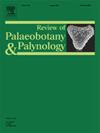畜牧业的强化~ 8 ka:来自印度喜马拉雅中部Rawatsera古湖泊沉积物剖面的非花粉孢谱分析
IF 1.7
3区 地球科学
Q2 PALEONTOLOGY
引用次数: 0
摘要
非花粉孢粉形态(NPP)作为古生态指标和人为干扰指标的应用正在迅速增长,因为它们有可能理解过去群落和环境的孢粉重建。此外,人们对印度畜牧业的起源和发展知之甚少。本文利用印度Kumaun(小喜马拉雅)Rawatsera古湖泊2.75 m长的沉积物剖面,分析了NPP,特别是真菌NPP和粪菌孢子(SCF),以了解全新世中期的生态、草食(放牧)和人类压力。研究表明,在~ 8327 ~ 8041 cal yr BP (I区)之间,草食动物放牧和人类压力存在。随后在8041 ~ 7406 calyr BP (II区),放牧活动(人类压力)加剧。在~ 7406 ~ 6999 calyr BP (III区)之间,与I区相比,放牧和本地食草动物放牧增加了。非趋势对应分析也支持基于SCF的强化草食放牧(放牧)的发现。此外,与II区(~ 8041 ~ 7406 cal yr BP)相比,研究区周围的土壤侵蚀在~ 8327 ~ 8041 cal yr BP (I区)期间更多,但在~ 7406 ~ 6999 cal yr BP (III区)期间相对增加。因此,根据印度喜马拉雅中部Kumaun地区全新世中期(~ 8327-6999 calyr BP)真菌孢子(尤其是Glomus sp.)和SCF的恢复,可以推测出不同程度的土壤侵蚀(以及放牧)形式的人为干扰。本文章由计算机程序翻译,如有差异,请以英文原文为准。
Intensification of pastoralism ∼ 8 ka: Non-pollen palynomorphs analyses from the Rawatsera palaeolake sediments profile, Central Himalaya, India
The utility of non-pollen palynomorphs (NPP) as palaeoecological indicators and indicators of anthropogenic disturbances is rapidly growing because of their potential to comprehend palynological reconstructions of past communities and environments. Moreover, the initiation and development of pastoralism in India is poorly understood. We, in the present study, analyzed the NPP, especially the fungal NPP and the spores of coprophilous fungi (SCF), to understand the ecology, herbivore grazing (pastoralism) and human pressure during the Middle Holocene from a 2.75-m-long sediment profile from the Rawatsera palaeolake, Kumaun (Lesser Himalaya), India. The study demonstrated that between ∼ 8327 and 8041 cal yr BP (Zone I), herbivore grazing and human pressure was noticed, based on the recovered SCF. Subsequently between ∼ 8041 and 7406 cal yr BP (Zone II), the grazing activity (human pressure) intensified. Between ∼ 7406 and 6999 cal yr BP (Zone III), compared to Zone I, pastoralism and local herbivore grazing increased. The detrended correspondence analysis also supports the findings of intensified herbivore grazing (pastoralism), based on the SCF. Moreover, soil erosion, compared to Zone II (∼ 8041–7406 cal yr BP), was more during ∼ 8327–8041 cal yr BP (Zone I), but comparatively increased during ∼ 7406–6999 cal yr BP (Zone III) around the study area. Anthropogenic disturbance of varying degrees in the form of soil erosion (and grazing too) was, therefore, suggested, based on the recovery of fungal spores, especially Glomus sp., as well as the SCF during the Middle Holocene (∼ 8327–6999 cal yr BP) from Kumaun, Central Himalaya, India.
求助全文
通过发布文献求助,成功后即可免费获取论文全文。
去求助
来源期刊
CiteScore
3.50
自引率
21.10%
发文量
149
审稿时长
6 months
期刊介绍:
The Review of Palaeobotany and Palynology is an international journal for articles in all fields of palaeobotany and palynology dealing with all groups, ranging from marine palynomorphs to higher land plants. Original contributions and comprehensive review papers should appeal to an international audience. Typical topics include but are not restricted to systematics, evolution, palaeobiology, palaeoecology, biostratigraphy, biochronology, palaeoclimatology, paleogeography, taphonomy, palaeoenvironmental reconstructions, vegetation history, and practical applications of palaeobotany and palynology, e.g. in coal and petroleum geology and archaeology. The journal especially encourages the publication of articles in which palaeobotany and palynology are applied for solving fundamental geological and biological problems as well as innovative and interdisciplinary approaches.

 求助内容:
求助内容: 应助结果提醒方式:
应助结果提醒方式:


